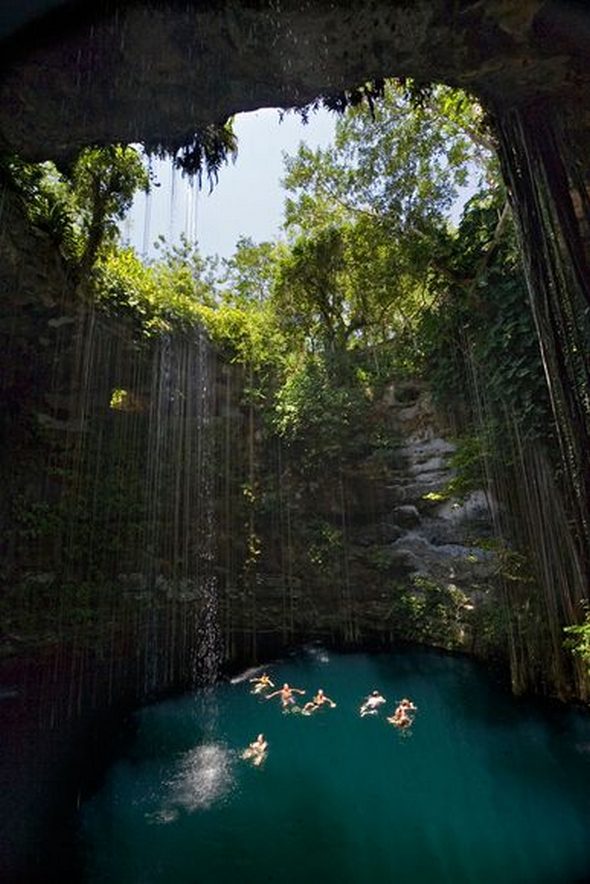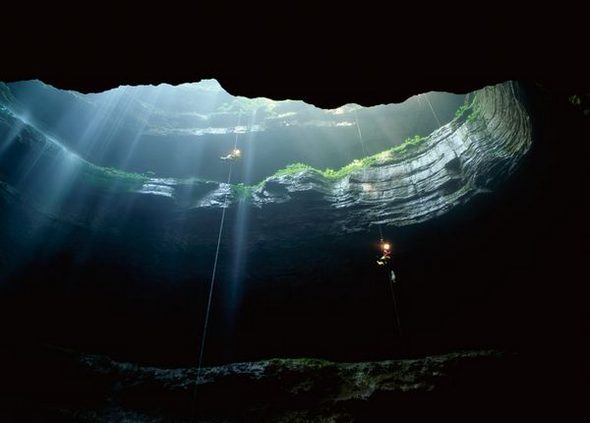This 185-foot-deep (56-meter-deep) sinkhole appeared in 1994 in Mulberry, Florida (map), in a pile of waste material dumped by mining company IMC-Agrico. The company was mining rock to extract phosphate, a main ingredient in fertilizers and a chemical used to produce phosphoric acid, added to enhance the taste of soda and various food items.After phosphate was extracted from the rocks, the gypsum-based waste product was dumped as a slurry. As layer after layer of the stuff dried, it formed cracks, like those that appear in dried mud. Water later made its way through the cracks and carried away subsurface material, setting the stage for a sinkhole.
5. Blue Hole, Belize
Sinkholes can happen anywhere water can erode a vertical channel that connects to a horizontal drain, a situation that allows a column of solid material to wash away, Missouri State’s Gouzie explained.
If the sinkhole is near the sea—or in the sea, as with the famous Blue Hole in Lighthouse Reef off the coast of Belize—seawater can quickly seep in after a collapse, forming a deep pool.
6. Picher, Oklahoma, Sinkhole
Years of mining for zinc and lead has left Picher, Oklahoma, near the border with Kansas, literally full of holes—including this sinkhole seen in 2008. Some mines were dug too close to the surface, and the roofs were unable to support the weight of earth on top, leading to collapses.
“It has happened in Missouri and in western Pennsylvania from coal mining,” Missouri State’s Gouzie said. “We’ve gotten better with buidlng mines so the roofs can support the weight over top of them.”
7. Iceland Sinkhole
Adventure kayaker Mick Coyne lowers himself down the wall of a sinkhole toward the headwaters of the Jokulsa, Iceland’s second longest river. Though the river is fed by melt from a glacier, this 150-foot (45-meter), inverted funnel-shaped hole was blasted into being by rising steam from geothermal vents below.
8. Ik-Kil Cenote, Mexico
Swimmers float in the saphirre waters of the Ik-Kil cenote, near the Maya site of Chichén Itzá in Mexico’s Yucatán Peninsula. Cenote means “natural well” in Spanish. Sinkholes occurring at sea level will fill up as high as the water table, creating the famous clear blue pools, used by the Maya royalty for both relaxation and ritual sacrifices.
9. Neversink Pit, Alabama
Neversink Pit, a wet limestone sinkhole in Alabama seen above in 1998, is about 50 feet (15 meters) deep and houses a rare species of fern. The sinkhole was bought in the 1990s by a group of cavers to preserve it for future generations.
Karst is the geologic term for landscapes formed mainly by the dissolving of limestone or dolomite bedrock. In the United States, karst underlies parts of Missouri, Arkansas, Kentucky, Tennessee, northern Alabama, Texas, and most of Florida. Such areas are marked by sinking streams, subterranean drainage, large springs, caves—and, of course, sinkholes.